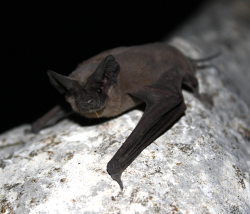Bats are nocturnal, carnivorous, furry warm-blooded mammals. There are more than 1,200 species of bats. Their fingers are attached by a membrane of skin called the patagium which allows them to fly. Depending on the species of bat, their wingspan can vary from 6 inches to over 5 ft. Since their legs are not as large as those of birds, bats hang upside down in order to take flight. Hanging upside down also allows them to hide from predators. Bats use echolocation to hunt their prey and mostly capture their prey while in flight.
5 BAT MYTHS
- BATS WILL SUCK YOUR BLOOD
There is only one species out of 1,200 bat species that consume blood as a food source. The vampire bat inhabits Mexico an South America but only feeds on the blood of sleeping horses, pigs, birds, and cow.
- BATS ARE BLIND
Bats are not blind. In fact, their small sensitive eyes allow them to see well, especially at night to help them capture food.
- ALL BATS HAVE RABIES
Per the CDC, it is estimated that <1% of bats are infected with rabies. This does not mean to be less cautious.
Bats are known carriers of histoplasmosis, an airborne disease with symptoms similar to the flu. Adults over 55, children under 2, and anyone with a weakened immune system is at a higher risk.
- BATS ARE OUR ENEMIES
Bats are very beneficial to our environment. A bat can eat over 1,000 mosquitoes in just one hour! They also pollinate more than 700 kinds of plants!
- BATS ARE FLYING RATS
Bats are not rodents! Rodents are members of the order Rodentia, while bats belong to the order Chiroptera.
FOUR BAT FACTS YOU WON’T BELIEVE
- Bats are the only flying mammal.
- Bats are responsible for pollinating over 700 kinds of plants.
- Bats can consume over 70% of their body weight a night (that’s a lot of mosquitos!).
- Bats generally give birth to one pup at a time, but like humans, twins pups are possible!

WHERE DO BATS LIVE?
Bats can be found in mostly any habitat aside from the Arctic with tropical areas having the most varieties in bat species. They are found in both urban and suburban areas. They utilize trees, caves, bridges, chimneys, attics, and other dark areas to roost. Bats will continue to utilize our homes and buildings as destruction to their natural habitat continues.
FIVE SIGNS YOU HAVE BATS
- You are hearing fluttering noises at night
- You hear chirping sounds
- You see staining/droppings on the exterior of your property near entry points
- You smell a strong ammonia odor inside or around your property
- You see bats flying around or in and out of your home
Please call your Trutech Wildlife Professional with any questions concerning bats. We want to keep you safe while keeping the bats safe too!


